The AMD 3rd Gen Ryzen Deep Dive Review: 3700X and 3900X Raising The Bar
by Andrei Frumusanu & Gavin Bonshor on July 7, 2019 9:00 AM EST** = Old results marked were performed with the original BIOS & boost behaviour as published on 7/7.
Benchmarking Performance: CPU Rendering Tests
Rendering is often a key target for processor workloads, lending itself to a professional environment. It comes in different formats as well, from 3D rendering through rasterization, such as games, or by ray tracing, and invokes the ability of the software to manage meshes, textures, collisions, aliasing, physics (in animations), and discarding unnecessary work. Most renderers offer CPU code paths, while a few use GPUs and select environments use FPGAs or dedicated ASICs. For big studios however, CPUs are still the hardware of choice.
All of our benchmark results can also be found in our benchmark engine, Bench.
Corona 1.3: Performance Render
An advanced performance based renderer for software such as 3ds Max and Cinema 4D, the Corona benchmark renders a generated scene as a standard under its 1.3 software version. Normally the GUI implementation of the benchmark shows the scene being built, and allows the user to upload the result as a ‘time to complete’.
We got in contact with the developer who gave us a command line version of the benchmark that does a direct output of results. Rather than reporting time, we report the average number of rays per second across six runs, as the performance scaling of a result per unit time is typically visually easier to understand.
The Corona benchmark website can be found at https://corona-renderer.com/benchmark
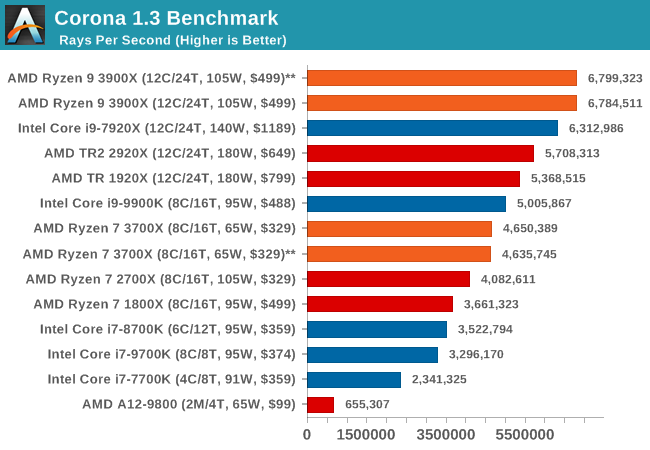
LuxMark v3.1: LuxRender via Different Code Paths
As stated at the top, there are many different ways to process rendering data: CPU, GPU, Accelerator, and others. On top of that, there are many frameworks and APIs in which to program, depending on how the software will be used. LuxMark, a benchmark developed using the LuxRender engine, offers several different scenes and APIs.

Taken from the Linux Version of LuxMark
In our test, we run the simple ‘Ball’ scene on both the C++ and OpenCL code paths, but in CPU mode. This scene starts with a rough render and slowly improves the quality over two minutes, giving a final result in what is essentially an average ‘kilorays per second’.

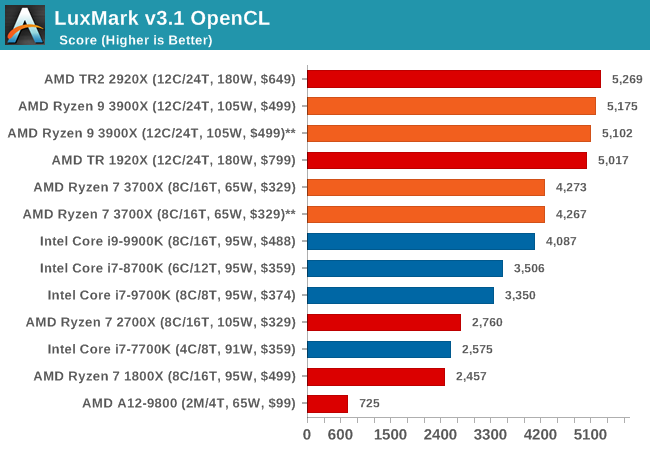
POV-Ray 3.7.1: Ray Tracing
The Persistence of Vision ray tracing engine is another well-known benchmarking tool, which was in a state of relative hibernation until AMD released its Zen processors, to which suddenly both Intel and AMD were submitting code to the main branch of the open source project. For our test, we use the built-in benchmark for all-cores, called from the command line.
POV-Ray can be downloaded from http://www.povray.org/
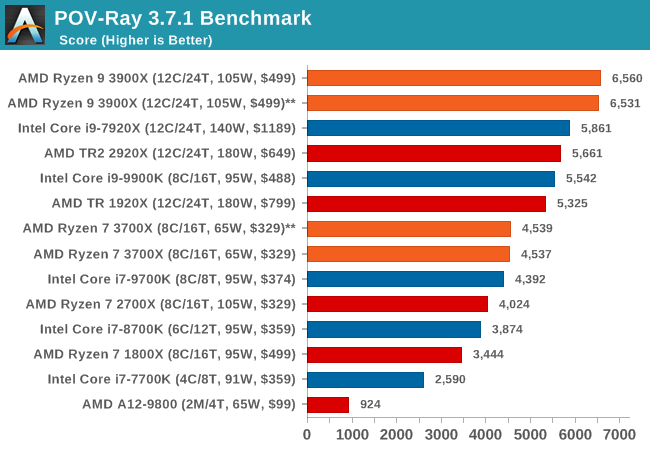
Cinebench R15
The latest version of CineBench has also become one of those 'used everywhere' benchmarks, particularly as an indicator of single thread performance. High IPC and high frequency gives performance in ST, whereas having good scaling and many cores is where the MT test wins out.
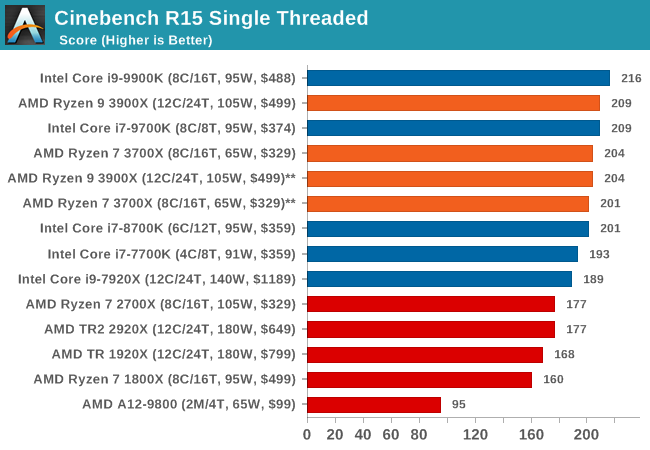
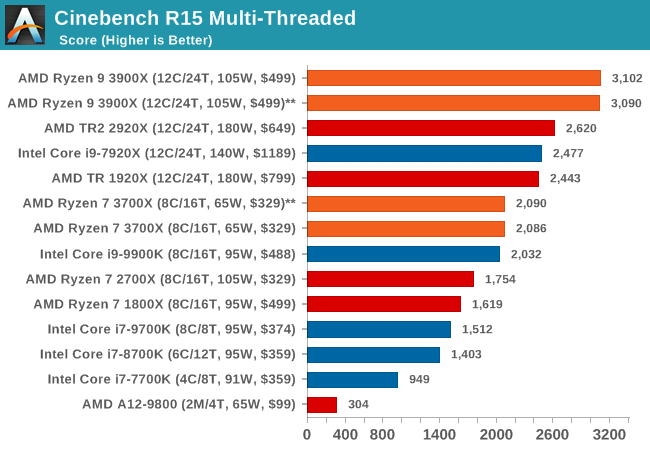











447 Comments
View All Comments
Andrei Frumusanu - Sunday, July 7, 2019 - link
CPUs are designed with memory latencies in mind when clocking at a certain clock - the current comparison at slightly different clocks is still perfectly valid for IPC.RSAUser - Monday, July 8, 2019 - link
Then show a power difference since the 9900K is double the draw...Mugur - Monday, July 8, 2019 - link
Done by other sites / youtube channels (at 4 Ghz). Ryzen 3000 is destroying Intel at the same clock.isthisavailable - Sunday, July 7, 2019 - link
With improved 7nm+ process for next gen, AMD can hit 5ghz and take the single core crown.Maxiking - Sunday, July 7, 2019 - link
Just like they did with the 14nm+ aka 12nm.Just like they were supposed to do with this gen.
But, but, but..?
sor - Sunday, July 7, 2019 - link
Actually that’s a bad example because we did see 200-300mhz bumps each generation between Ryzen 1000 and 3000. At that pace it’s possible to see a 5ghz turbo next generation, or be close enough.If you’re saying that everyone expected 5ghz with Ryzen 2000, then yes, if that’s true then those people were being unreasonable. At this point though it’s not a big leap.
Maxiking - Sunday, July 7, 2019 - link
It is a perfectly valid example, the bump between 1st gen and 2ng gen ryzen was 200mhz. Max OC on 1st gen was 4.1ghz, the max on the 2nd gen was 4.3ghz.There is no bump this year. I am highly skeptical they would be able to reach 4.6ghz on all cores with 7 nm+ next year. TSMC nodes are nothing special, you hit the wall and you are done regardless of voltage used.
sor - Sunday, July 7, 2019 - link
last year we had 3.7/4.3ghz as the flagship Ryzen 7 desktop. This year we get 3.9/4.5ghz in Ryzen 7 and up to 4.7ghz single threaded in Ryzen 9.These parts are well beyond anything we saw in the 2000 series, to claim there has been no frequency improvement is disingenuous at best. Going to 5ghz is just a small process tweak away this time.
Maxiking - Sunday, July 7, 2019 - link
Yeah and we were promised 3900x boosting up to 4.6ghz and it barely boost to 4.2ghz and can be manually overclocked to 4.3ghz.I will believe when I see it.
So no, there is no frequency boost with these chips.
Mugur - Monday, July 8, 2019 - link
You are wrong, 3900 is boosting to 4.55-4.6 single core all day.